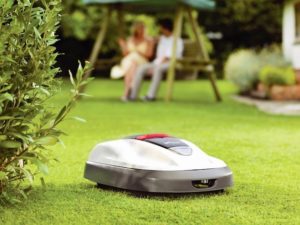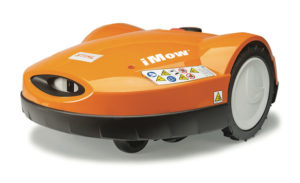The Rise of Robotic Mowers
By John Kmitta
With the growing popularity of “connected” or “smart” homes, homeowners are looking at the benefits of autonomous/robotic mowing.
However, it is not just homeowners identifying the potential for robotic mowers. Faced with increasing labor shortages, landscape industry professionals are now examining how robotic mowers might fit within their menu of services.

“Automation is not new. But automation in mowing is becoming the newest disruptor in the green industry,” said Elisha Lipscomb, senior marketing strategist, lawn and garden, at Honda (manufacturer of Miimo robotic mowers). Lipscomb added that while Miimo is primarily for residential use, Honda is seeing more homeowners and landscapers adopting robotic mowing.
“This can be the next life-changing technology. You are no longer tied to your house on the weekend. It makes your life easier,” she said. “Businesses can reallocate resources – especially with the labor issues going on right now in the landscape industry. The need to have multiple crews is reduced. Crews are working smarter, not harder”
Lipscomb added that robotic mowers free up more time, are constantly maintaining the lawn, and fertilize the lawn because the grass is cut in tiny snippets during each pass – resulting in a healthier lawn.
“Miimo and other robotic mowers run on battery – no oil or gas, and are pretty much maintenance free,” Lipscomb added. (Maintenance includes general cleaning, replacing blades, and occasionally inspecting the boundary wire.) “Everything is included in the box. You purchase the unit, get the boundary wire, installation, and it is pain free.”
Connected homes are priming the pump to get consumers to adopt this technology, said Brian Manke, new technology product manager, Stihl Inc., which manufactures iMow robotic mowers. On the landscaper side, it is push from the lack of labor, Manke added.

According to Steven Uljua, product manager for robotics at Husqvarna (manufacturer of the Automower line of robotic mowers), at GIE+EXPO three years ago, robotic mower manufacturers who suggested robotics as part of the landscape business model were laughed at by landscape professionals. Two years ago at the show, landscapers blamed robotic mowers for taking business away from the landscape contractor. However, Uljua said that he spent most of his time at the 2018 GIE+EXPO speaking with landscapers who are looking into robotics because of the labor shortage. Uljua said he asks landscapers if they could hire a worker who is on time every day, does not require benefits, but they only cut grass, would they hire that worker? Most would say, “yes,” he said.
Uljua added that many landscapers are struggling with the dilemma of either doing marginal work on all their clients’ properties (because of the labor shortage) or letting some clients go/turning down new clients in order to maintain the quality of work.
Robotic mowers free crews up to work on tasks such as blowing, string trimming, edging, hedge trimming, fertilization, and other jobs that are not likely to be replaced by robots or drones, he said.
“This is a device to help your business,” said Uljua. “When you put this in your business, you are keeping your employees busy and elevating them to a new level.”
Manke said that a landscape business model involving robotic mowers would be similar to the existing business model. “People will find different ways of selling it, and having the customer pay for it,” he said. “Whether the customer owns [the robotic mower] or if the landscaper owns it, the customer cares that their property looks maintained.”
The role of the dealer
“With our dealers, and dealers in general, they are buying into the technology but it is new,” said Lipscomb. “There is always a period with new technology and automation. That’s where we are at with robotics right now.”
Robotic mowers are not like traditional OPE, she added. Dealers have to be the experts, and they are implementing hands-on training with their staffs to get the technical knowledge. For Miimo, an authorized Miimo dealer would come out and do a landscape survey and then the dealer would come out install the system and educate the user.
“The connection is that most landscapers seek the dealer for advice,” said Uljua. “‘What equipment should I have?’ ‘Where should I invest my money?’ Dealers need to be up on this new technology.”
Uljua said the dealer network for Automower grows daily. There are some dealers who are used to working on chain saws and zero-turns, and robotic mowers take them out of their comfort zone, so they are in a wait-and-see mode. But some dealers adopted robotics early, and have been very successful with it.
“We are spending a lot of time getting to dealers and saying, ‘This is the future,’” he said.
Uljua added that successful dealers are selling robotic mowers as an all-in package, with the installation. They can charge for installation (which typically takes a couple hours), and there is often more profit margin on the installation than the margin they are making on the equipment itself.

“The early bird gets the worm,” said Manke. “This is definitely the ground floor. The dealers who get in early, get trained, get staff, and learn to install it will have an advantage. As it becomes more mainstream, those will be the guys who will know how to scale up. Technology like this tends to grow exponentially. You will hit that certain critical mass where everyone wants it. Having that institutional knowledge at the dealership, you can grow your business as the market grows. It’s all about training and understanding the technology.”
Uljua said that even if robotic mowers are not the right fit for a paticular customer or their landscape, if they come in the door thinking about purchasing a robotic mower and you sell them a zero-turn, chain saw or other piece of equipment instead, it brought a new customer into your dealership and away from the big box retailers. It provides another point of contact to help you educate the customer and help find the right piece of equipment to meet their needs.
“This technology is not going away,” he added. “Big companies are investing millions of dollars. You can get on that train early or sit back and someone else would be the one. You want to be the guy associated with robotics in your area. Be that player, and be that guy who embraces the future. Use robotics to bring in a new customer base.”
John Kmitta is associate publisher and editor of Outdoor Power Equipment magazine.


